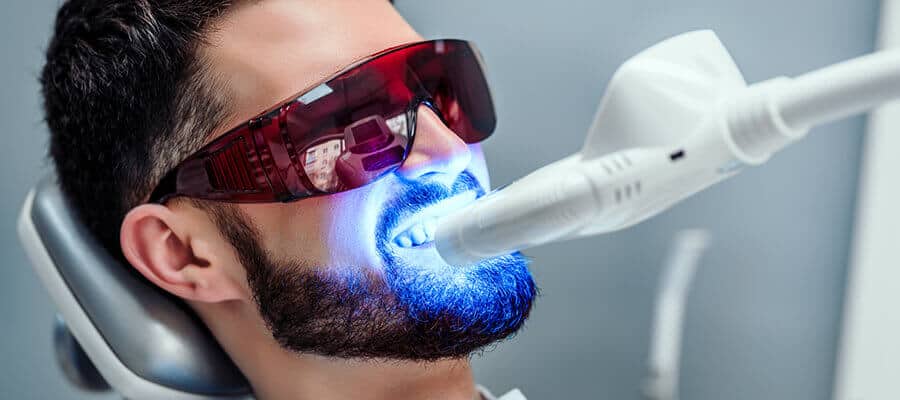
A sealant is a thin, plastic coating applied to the chewing surface of molars, premolars and any deep grooves (called pits and fissures) of teeth. More than 75% of dental decay begins in these deep grooves. Teeth with these conditions are hard to clean and are very susceptible to decay. A sealant protects the tooth by sealing deep grooves, creating a smooth, easy to clean surface.
Sealants can protect teeth from decay for many years, but need to be checked for wear and chipping at regular dental visits.
Reasons for sealants:
- Children and teenagers – As soon as the six-year molars (the first permanent back teeth) appear or any time throughout the cavity prone years of 6-16.
- Adults – Tooth surfaces without decay that have deep grooves or depressions.
- Baby teeth – Occasionally done if teeth have deep grooves or depressions and child is cavity prone.
What do sealants involve?
Sealants are easily applied by your dentist or dental hygienist and the process takes only a couple of minutes per tooth.
The teeth to be sealed are thoroughly cleaned and then surrounded with cotton to keep the area dry. A special solution is applied to the enamel surface to help the sealant bond to the teeth. The teeth are then rinsed and dried. Sealant material is carefully painted onto the enamel surface to cover the deep grooves or depressions. Depending on the type of sealant used, the material will either harden automatically or with a special curing light.
Proper home care, a balanced diet, and regular dental visits will aid in the life of your new sealants.
FAQs
What exactly are dental sealants?

Dental sealants consist of clear or tooth-colored plastic materials that are applied by Dr. Rader to the biting surfaces of back teeth – molars and premolars – and into the crevices of teeth. Their purpose is to serve as a shield against decay.
How do they function?
Dental sealants work by creating a protective shield over the enamel of each tooth where they are applied. This shield prevents food particles and bacteria from getting into the tiny grooves of the teeth, making them prone to decay.
Who benefits from sealants?
Children and adolescents are the prime candidates for dental sealants, as they are more prone to cavities between the ages of 6 and 16.
However, even adults can take advantage of sealants if their teeth have deep pits or fissures that they want to be kept free from fillings or decay.
How long do sealants usually last?
Dental sealants can last for several years, but they must be inspected regularly for any signs of wear or damage during routine dental checkups to ensure they continue to provide protection.
What’s the application process?

The procedure for applying sealants is meticulous but straightforward:
First, the teeth are cleaned and cleared of any plaque or particles.
Then, the teeth are dried, and an acidic gel is applied to roughen the surface, which assists in the adhesion of the sealant.
Finally, the sealant is painted onto the tooth enamel and set with a curing light.
Are sealants widely used?
Dental sealants are a common form of preventive dental care, with a large number of school-aged children and teenagers in the U.S. benefiting from their application.
Are they only meant for kids?
No, while they are commonly used in pediatric dentistry, sealants can also be valuable for adults whose molars are decay-free, providing an extra layer of defense against cavities.
Why should my child get sealants?
Opting for dental sealants for your child can drastically diminish the likelihood of tooth decay, promoting a healthier dental future during their most cavity-susceptible years.
How can I ensure their longevity?
To ensure the durability of dental sealants, maintain regular dental check-ups and adhere to excellent oral hygiene practices, such as thorough brushing and flossing.
Can sealants be applied to teeth that already have cavities or fillings?
Sealants are best suited for healthy teeth without decay. However, they can sometimes be used on teeth with initial signs of decay to halt further damage. Teeth with existing fillings are typically not candidates for sealants.
How do they compare to other preventive treatments like fluoride?
Sealants and fluoride treatments serve different purposes; sealants provide a physical barrier against decay, while fluoride reinforces the teeth’s enamel against acid attacks. Some patients may benefit from both treatments for all-encompassing decay prevention.
What type of expense is involved?
The price of dental sealants can vary, depending on factors like how many teeth need sealing, the dental practice, and the location. Many dental insurance plans cover the cost (although it is always wise to check with your individual insurance provider to clarify).
Are there any risks or adverse effects associated with sealants?
Dental sealants are generally safe, though there’s a small risk of allergic reactions to the materials used. Also, if not applied correctly, sealants could potentially enclose bacteria under them, leading to decay.






